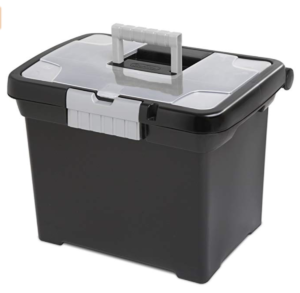So you’re thinking about starting a psychotherapy private practice, but how much does it cost? I know from experience that it can often feel like, I guess you’re just supposed to get started, pay the money, and find out later how much it costs.
But it doesn’t have to be that way! In this post, I break down the costs of starting a private practice in counseling and share some tips for how you can save money if you’re on a budget.

Today’s post is specifically focused on the start-up costs for part-time private practice.
Why I recommend starting part-time in private practice
Why part-time? I recommend that if you’re interested in starting a private practice in counseling that you start part-time, get your toes wet, save a bunch of money, and see if private practice is right for you before diving in full-time.
Take that recommendation with a grain of salt. Some of you are all-in, go-getter, grab life by the horns type of people who don’t believe in doing things halfway. If that’s you, I get it! I’m like that too. By all means, dive in full-time from the get-go if that’s who you are.
But for most people, the best way to set yourself up for success in private practice is to start part-time and build up slowly. Everyone has different experiences with how long it takes to start turning a profit, and it’s SO much easier to have a profitable business if you keep your overhead costs low by starting part-time.
Sadly, I’ve watched many therapists dive in full-time from the get-go with no clear business plan or marketing strategy. Usually, these practices close down within 6 months to a year. How deflating!
Costs of Starting a Private Practice in Counseling
Keep in mind that costs vary widely depending on where you live and how frugal you want to be as you get started. However, if you go through this checklist you should be able to get a pretty clear idea of how much it’ll cost you before you have to pay for anything.
Expense 1: Website
First, start with your website. You could technically do this for free if you want, but I recommend you go with an option that’s ad-free and allows you to have your own domain name.
If you build your own website, these kinds of sites can range anywhere from $15 to $35 per month, or you can pay a much higher premium and have somebody else design a website for you.
If you’re curious about your options for building a website, I go over that in much more detail in my post: What’s the Best Website Builder for Therapists?
Expense 2: Office Space
Unless you’re planning on providing exclusively teletherapy services, you need an office space in order to practice.
There are two ways to go about finding a part-time office space:
- Rent per hour and only pay per number of client sessions you use the space for, or
- Sublet one day a week or a couple of evenings per week to start.
Usually, the rent per hour option is a bit trickier to find. Your best bet for finding it is if you know a colleague or others within your networks who are willing to share their space with you. This is the cheapest option and the easiest on-ramp into private practice.
As an example, in my area the hourly rate is usually about $15-$18 per hour. If you were actually using the space full-time at this price, the monthly rent would be astronomical. However, if you are just using the office for one or two hours per week to start then you spare yourself the cost of having to pay for a space full-time that might be mostly empty for some time.
The downside of the hourly rental option is that you may have to build your schedule around someone else’s, which is why this option works best as a temporary plan while you get started in private practice.
If you sublet one day a week or a couple of evenings per week, then you know that the space is yours for that full day or that designated chunk of time, but it also can cost a bit more.
As an example, to sublet one day a week in my city, per month you end up spending about $180 and it goes up from there.
Keep in mind that rental prices vary widely depending on where you live, but a little bit of research on Craigslist should give you a pretty good sense of what the going rate is in your area. It’s helpful to do this work first before spending a dime so you have a sense in advance of how much rent will cost you.
Expense 3: Liability Insurance
Super important! Just because you’re starting private practice part-time, it doesn’t mean you can fly under the radar. You are just as liable for your work as anyone else.
Liability insurance will probably be your biggest expense when you start private practice part-time. However, the good news is a lot of insurance companies have incentives for people who are just starting out and they charge less when you’re in your early career.
I’ve seen rates as low as $400 for the first year, but you do usually have to pay it all upfront.
Expense 4: City Business License
Once again, this expense varies widely depending on what city you live in. But nearly every city has some laws requiring that every business obtain a city business license. As is the case with liability insurance, just because you’re starting part-time, it doesn’t mean you have permission to skip this expense.
To give you a sense of the cost ranges I’ve seen in my area, I’ve practiced in three different cities in the Bay Area and the annual fee for the city license ranged from $90 up to $200 a year depending on which city I practiced in.
Be sure to check with your local city laws and policies to see if you need a business license and how much it costs.
Expense 5: Documentation System
Whether you need a file cabinet for pen-and-paper documentation or a practice management system to document online, this is an important expense to account for when getting started.
Despite my love of technology, I’m a bit old school after a few scarring experiences with practice management systems. Personally, I made the decision to do all paper files for my client charts at this time.
If you decide to go with paper charting, all you need is a small portable file box with folders. I used a small one for my first couple of years when I was just subletting. It needs to be portable so just make sure it has a handle and then, of course, make sure there’s a way for you to lock it in order to comply with HIPAA laws.
If you’re interested, here’s a link to the one I used early on:

It was under $20 and I bought a lock from the dollar store. Worked for me for several years! When I upgraded, I passed it on to my colleague who started subletting from me.
If you go with a practice management system it costs a bit more money, but most therapists do go with this option rather than pen-and-paper.
As an example, Simple Practice‘s most basic subscription service is $39 a month and it goes up from there.
Optional Expenses
Here are some additional items that you could either get for free or forego all together. You might decide though to pay for some of these items based on your needs and preferences.
- Phone Service. I use Google Voice which is totally free and forwards to my personal smartphone. I don’t recommend you use your personal number as your therapy practice number, as this option both violates HIPAA and also makes it difficult to separate your work and personal life. It is also an option to pay for your own professional phone line.
- Professional Email. Most therapists these days use email, and most of my clients communicate with me through email for the first contact and between sessions. There are free email options available, but you run up against some issues with HIPAA compliance if you go this route. I use G suite which costs only $5 a month (it’s about to go up to $6 shortly). With a little bit of tweaking in the settings, you can make your email HIPAA compliant.
- Business Cards. This is completely optional. I used these for several years, but I recently stopped as most clients just Google my name to remember my contact info (thus the benefit of having a great SEO game. Check out my article: SEO for Therapists: Keyword Planning). If you decide to get business cards, the cheapest option for that is probably VistaPrint. If you keep an eye out they frequently have 50% off promotions and you can get a pack of a hundred for maybe 8 bucks. Start with the smallest box you can find. If you’re subletting, you will probably move to a new location before long and you’ll end up ordering new business cards to keep your address up-to-date.
- Online Directories. This is completely optional. If you do go this route, you could do Psychology Today. It’s usually easy to find a six-month free trial, so it seems totally worth it to go ahead and try it. You can always decide later if you’d like to keep that open and pay for it. But you can skip this step and save yourself that money of course.
I’ve offered this list of expenses in private practice with the assumption that you have access to some type of online device and some type of internet. So putting all of that together, if you’re really frugal like me and you wanted to start a part-time practice in the city that I live in, you could get everything started up and running for just over $800 upfront cost (most of which is liability insurance), and then a monthly cost of about $195 dollars each month after that.
Just think about it: you could reasonably save that money up and spend it all at once without needing to go into any debt, and that’s super awesome!
This is the exact strategy that I used when I started a private practice in my current city, and I recouped all of my costs within the first two months of starting a private practice.
I hope you found this helpful in giving you an idea of the costs of starting a private practice in counseling, even if you’re on a budget.
If you’re thinking about taking the plunge into private practice but you aren’t sure where to start, check out my free guide that walks you through everything you need to know to get started in private practice: Start a Private Practice in Counseling.
Until next time, from one therapist to another: I wish you well.
-Marie
Photo by Sidekix Media on Unsplash
Leave A Reply